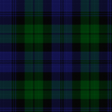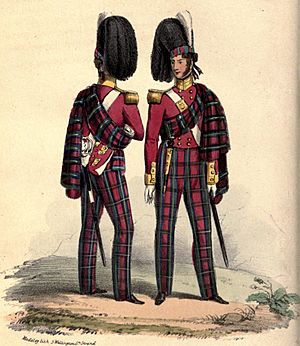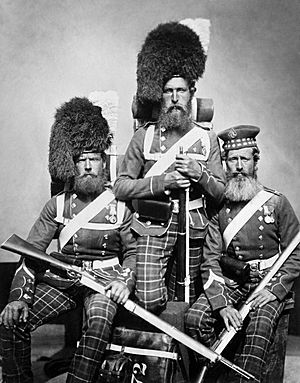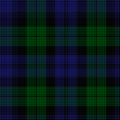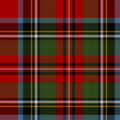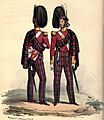72nd Regiment, Duke of Albany's Own Highlanders facts for kids
Quick facts for kids 72nd Highland Regiment |
|
|---|---|
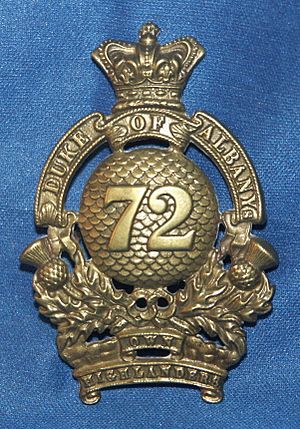
Regimental cap badge
|
|
| Active | 1778–1881 |
| Country | |
| Branch | |
| Type | Infantry Regiment |
| Size | One battalion (two battalions 1804–1816) |
| Garrison/HQ | Stirling Castle (1873–81) |
| Nickname(s) | The Wild Macraes |
| Engagements | Second Mysore War (1782–84) Third Mysore War (1789–92) Siege of Pondicherry (1793) Cape of Good Hope (1806) Isle de France (1810) South Africa (1835) Crimean War (1855–56) Indian Rebellion (1858) Second Afghan War (1878–80) |
| Insignia | |
| Tartan | |
The 72nd Highlanders was a famous Scottish infantry regiment in the British Army. It was formed in 1778 and was originally called the 78th Regiment. Later, in 1786, its number was changed to 72nd. In 1881, it joined with another regiment, the 78th (Highlanders) Regiment, to become the 1st Battalion of the Seaforth Highlanders.
Contents
The Story of the 72nd Highlanders
How the Regiment Started
The regiment was created in January 1778 by Kenneth Mackenzie, 1st Earl of Seaforth. He wanted to show thanks because his family's old title, the Earl of Seaforth, was given back to them. This title had been taken away after a rebellion in 1715.
About 1,130 men joined, mostly from the Scottish Highlands. They gathered at their first base in Elgin in May 1778.
A Protest in Edinburgh
In August 1778, the soldiers marched to Leith to sail to India. But they had a disagreement about their service terms. About half the men marched back to Edinburgh and protested on Arthur's Seat, a hill near the city. They stayed there for several days.
People in Edinburgh supported them and brought them food. News of their protest even reached London newspapers. After three days of talks, they reached an agreement, and the soldiers were forgiven. They marched back to Leith, led by the Earl of Seaforth. The plan to send them to India was cancelled. At this time, the regiment was called the 78th (Highland) Regiment of Foot.
Early Adventures and Challenges
In September 1778, the regiment sailed to Jersey. In May 1779, they helped stop a French invasion there. They then moved to England in April 1781.
In June 1781, the regiment set sail for India from Portsmouth. There were 973 soldiers. The journey was very tough due to a change in diet, rough seas, and a disease called scurvy. Sadly, 274 men died on the way, including the Earl of Seaforth. His cousin, Lieutenant Colonel Thomas Frederick Mackenzie Humberston, took command.
When they arrived in Madras on April 2, 1782, only 369 soldiers were healthy enough to fight. They joined the army of Sir Eyre Coote. Because of their poor health, they were not ready for battle. The healthy soldiers joined another regiment, the 73rd (Macleod's Highlanders) Regiment.
By October 1782, the soldiers had recovered. They were ready to fight in the wars against Tipu Sultan. Colonel Humberston Mackenzie was killed in April 1783 during a battle at sea. After his death, Major-General James Murray became the new colonel in November 1783.
Changes and New Battles
Many soldiers had signed up for three years. In 1784, 425 of them chose to leave and go back to Scotland. The rest decided to stay in India. Other soldiers from different regiments also joined them, bringing the regiment's total to 700 men.
After the war with the French ended, the number of regiments was reduced. On September 12, 1786, the regiment was re-numbered as the 72nd (Highland) Regiment of Foot.
In December 1789, the Third Anglo-Mysore War began. The regiment fought in important battles like the siege of Bangalore in February 1791, the siege of Savendroog in December 1791, and the siege of Seringapatam in February 1792. This last battle ended the war.
The regiment stayed in India and later fought in the siege of Pondicherry in August 1793 during the French Revolutionary Wars. They then went to Ceylon in 1794 and helped take the island from the Dutch. In February 1798, the regiment returned home to Scotland. Many of their men, however, joined other regiments that stayed in India. Back in Scotland, 900 new men joined from home-defence units called Fencible Regiments.
Fighting in the Napoleonic Wars
In 1801, the 72nd Regiment moved to Ireland. A second group of soldiers (a second battalion) was formed in 1804. This group stayed in the United Kingdom and was later disbanded in 1816.
In August 1805, the first battalion sailed to Madeira and then to the Cape of Good Hope at the end of the year. They fought in the Battle of Blaauwberg against the Dutch in January 1806.
In April 1809, the regiment was renamed the 72nd Regiment of Foot. They also stopped wearing their traditional Highland uniform. However, they kept many Scottish traditions, like having pipers, even if it wasn't official. From South Africa, the first battalion sailed again and took part in the Invasion of Isle de France (Mauritius) in December 1810.
They returned to Cape Town in June 1814 and stayed there until March 1822, except for a short time in India in 1815. In December 1823, the regiment was renamed the 72nd (or Duke of Albany's Own Highlanders) Regiment of Foot. They started wearing Highland dress again, but with trews (trousers) instead of kilts. Only the pipers wore kilts.
The Victorian Era Battles
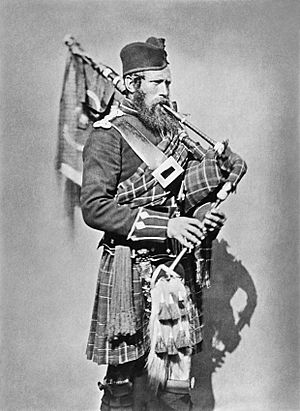
In June 1828, the regiment sailed to South Africa again. They fought in the Sixth Xhosa War from 1834 to 1835 before returning home in May 1840. In August 1842, they helped stop a strike in Preston, England.
They were then sent to Gibraltar in November 1844 and to Barbados in February 1848. The regiment moved to Halifax, Nova Scotia, in July 1851 and returned home in October 1854.
The next year, the regiment went to Malta and then to the Crimean War, arriving in May 1855. They fought bravely at the siege of Sevastopol. They came home in 1856.
In August 1857, they moved to India to help stop the Indian Rebellion. They fought in the Central Indian campaign of 1858. The regiment stayed in India until 1866, then returned home.
They went back to India in 1871. The regiment played a big part in the Second Anglo-Afghan War from 1878 to 1880. They fought in battles like Peiwar Kotal in November 1878, Charasiah in October 1879, and the siege of the Sherpur Cantonment near Kabul in December 1879. They were also part of General Robert's march from Kabul to Kandahar and fought in the Battle of Kandahar in September 1880.
The End of the Regiment
In the 1870s, changes were made to the British Army. The 72nd Regiment was linked with the 91st (Argyllshire Highlanders) Regiment of Foot. They shared a training base at Stirling Castle.
On July 1, 1881, more changes happened. The 72nd Regiment joined with the 78th (Highlanders) Regiment to form the 1st Battalion of the Seaforth Highlanders. This meant the 72nd Highlanders, as a separate regiment, no longer existed.
Special Awards and Honours
Battle Honours
These are special awards given to regiments for their bravery in battles:
- Carnatic (1782–96)
- Hindoostan (1782–96)
- Mysore (1782–96)
- Cape of Good Hope (1806)
- South Africa (1835)
- Sevastopol (1855)
- Central India (1855)
- Afghanistan 1878–80, Peiwar Kotal, Charasiah, Kabul, Kandahar (1878–80)
Victoria Cross Heroes
The Victoria Cross is the highest award for bravery in the British military. Two soldiers from the 72nd Highlanders received this honour:
- Lieutenant Aylmer Spicer Cameron for his actions during the Indian Mutiny on March 30, 1858.
- Lance-Corporal George Sellar for his bravery during the Second Afghan War on December 14, 1879.
Images for kids
-
Pipe Major John Macdonald who served in the Crimean War


